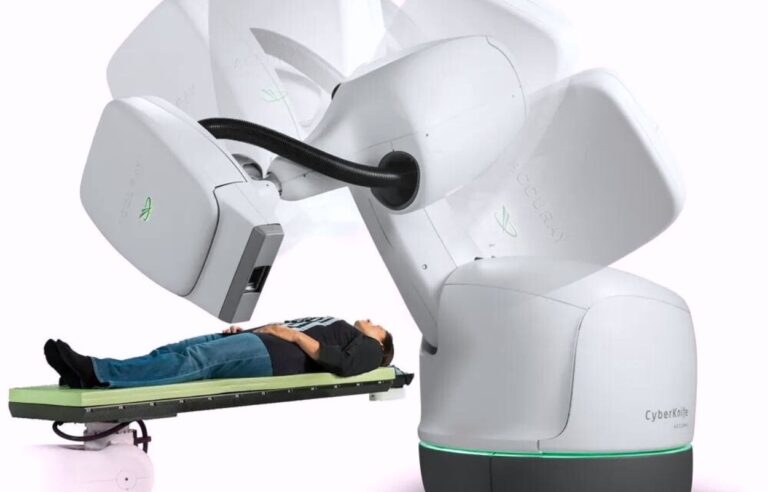In the rapidly evolving field of cancer treatment, CyberKnife technology has emerged as a groundbreaking solution for delivering precise, non-invasive radiation therapy. As a state-of-the-art alternative to conventional radiotherapy and surgical interventions, CyberKnife offers unmatched accuracy and patient comfort. This innovative treatment method is designed to target tumors and lesions throughout the body with millimeter precision, minimizing damage to surrounding healthy tissues.
In this blog post, we’ll explore what CyberKnife is, its indications, benefits, and what makes it an exceptional choice for cancer treatment.
What is CyberKnife?
CyberKnife is a robotic radiosurgery system that delivers highly targeted radiation to tumors with exceptional precision. Unlike traditional radiotherapy, CyberKnife uses advanced image-guidance technology and a robotic arm that adjusts in real-time to the patient’s slightest movements. This adaptability allows the system to target tumors in complex or hard-to-reach areas without invasive procedures or rigid immobilization devices.
CyberKnife treatment is non-surgical and typically performed on an outpatient basis, providing patients with a comfortable experience and minimal recovery time.
Indications for CyberKnife Treatment
CyberKnife technology is highly versatile, making it suitable for treating various types of cancer and non-cancerous conditions. Common indications include:
1. Brain Tumors
- Primary and metastatic brain tumors
- Benign tumors such as meningiomas or acoustic neuromas
- Arteriovenous malformations (AVMs)
2. Spine Tumors
- Spinal metastases
- Benign spinal lesions
- Spinal cord tumors
3. Lung Cancer
- Early-stage non-small cell lung cancer (NSCLC)
- Oligometastatic lung lesions
4. Prostate Cancer
- Early-stage prostate cancer
- Patients seeking a non-invasive alternative to surgery
5. Liver and Pancreatic Tumors
- Unresectable or recurrent tumors in these vital organs
6. Other Conditions
- Trigeminal neuralgia
- Certain types of vascular malformations
Advantages of CyberKnife Treatment
CyberKnife has gained significant attention due to its numerous benefits. Here’s why it stands out:
1. Exceptional Precision
The robotic arm’s real-time tracking capabilities ensure radiation beams follow the tumor’s movement, even during breathing or minor body shifts. This precision minimizes exposure to surrounding healthy tissues, reducing side effects.
2. Non-Invasive Procedure
Unlike traditional surgery, CyberKnife requires no incisions, anesthesia, or hospitalization. Patients can typically return to their daily activities immediately after treatment.
3. Shorter Treatment Duration
CyberKnife often requires fewer sessions compared to conventional radiation therapies. While standard radiotherapy may involve 20-30 sessions, CyberKnife treatment can often be completed in just 1 to 5 sessions.
4. Improved Comfort
CyberKnife eliminates the need for uncomfortable frames or invasive immobilization devices, enhancing patient comfort during the procedure.
5. Suitable for Inoperable Tumors
For patients with tumors in delicate or hard-to-reach areas that are deemed inoperable, CyberKnife offers a safe and effective alternative.
6. Minimal Side Effects
Due to its focused radiation delivery, side effects such as fatigue, skin irritation, and tissue damage are significantly reduced.
The CyberKnife Treatment Process
1. Consultation and Evaluation
Patients first undergo a detailed evaluation by an oncology specialist to determine if CyberKnife is the best treatment option for their condition.
2. Treatment Planning
Advanced imaging techniques, such as CT, MRI, or PET scans, are used to map the tumor’s precise size, shape, and location. This data is integrated into the CyberKnife system to create a personalized treatment plan.
3. Treatment Delivery
During the session, the patient lies comfortably on a treatment table. The robotic arm delivers precise radiation doses while continuously tracking the tumor’s movement.
4. Follow-Up Care
Post-treatment follow-ups are essential to monitor the patient’s response and ensure optimal outcomes.
Who is an Ideal Candidate for CyberKnife?
CyberKnife may be ideal for patients who:
- Have small to medium-sized tumors
- Are seeking a non-surgical treatment option
- Require radiation therapy for tumors in sensitive areas like the brain, spine, or lungs
- Have previously undergone surgery or conventional radiation therapy without success
Why Choose CyberKnife for Cancer Treatment?
CyberKnife’s combination of precision, comfort, and effectiveness has revolutionized cancer care. Its ability to treat previously inoperable tumors offers hope to patients seeking advanced solutions with minimal disruption to their daily lives.
If you or a loved one is exploring innovative cancer treatment options, CyberKnife may provide the targeted and effective care you need.


